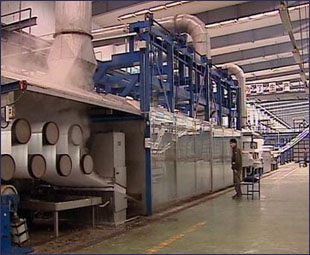| Home / Environment / International Cooperation | Tools: Save | Print | E-mail | Most Read |
| Rural Industries Are Going for Green |
| Adjust font size: |
Chinese rural enterprises - big polluters in the country - are finding ways of reducing energy consumption and greenhouse-gas emissions under a new project. Funded by the Global Environment Facility, a technological transformation program is helping 100 rural enterprises save China 451,000 tons of coal and reduce carbon dioxide emissions by 1.13 million tons annually, according to Vice Minister of Agriculture Wei Chao'an.
(File photo: a rural enterprise) Only eight firms signed up for the project in 2001 when it was launched with US$8 million from the facility. The project aims to help Chinese rural enterprises in the brick-making, cement, foundry and coking sectors reduce greenhouse gas emissions by improving their production methods. Statistics show rural enterprises in the four sectors account for 16.7 percent of China's carbon dioxide emissions and use up 56 percent of the energy consumed by all Chinese rural firms. China has 23 million rural enterprises, producing 30 percent of the country's gross domestic product and providing 143 million unskilled farmers with job opportunities. "These enterprises used to be bedeviled with environmental problems such as low energy efficiency, high consumption and heavy pollution," said Wang Xiwu, an official with the Project of Energy Efficiency and Greenhouse Gas Emissions Reduction for Chinese Rural Enterprises. The 100 rural enterprises were chosen as "role models" to encourage more firms to take part in the program, as well as to exhibit the government's resolution in reducing greenhouse gas. According to Wei, an increasing number of rural enterprises have voluntarily signed mid and long-term pledges with local governments, promising to reduce energy consumption and greenhouse gas emissions, said Bai Jinming, an official with the Ministry of Agriculture. The government in turn have allowed them to enjoy preferential policies in tax payments, fundraising and technological research, said Bai. As a developing country, China is not obligated to meet targets set by the Kyoto Protocol, under which 38 industrialized countries must reduce their greenhouse gas emissions by an average of 5.2 percent below 1990 levels, during the period 2008 to 2012. But the Chinese government realized it must do its part to slow global warming as the country has become the world's second largest carbon dioxide emitter and is likely to overtake the United States in the near future. (Xinhua News Agency May 21, 2007) |
| Tools: Save | Print | E-mail | Most Read |
 |
| Related Stories |
